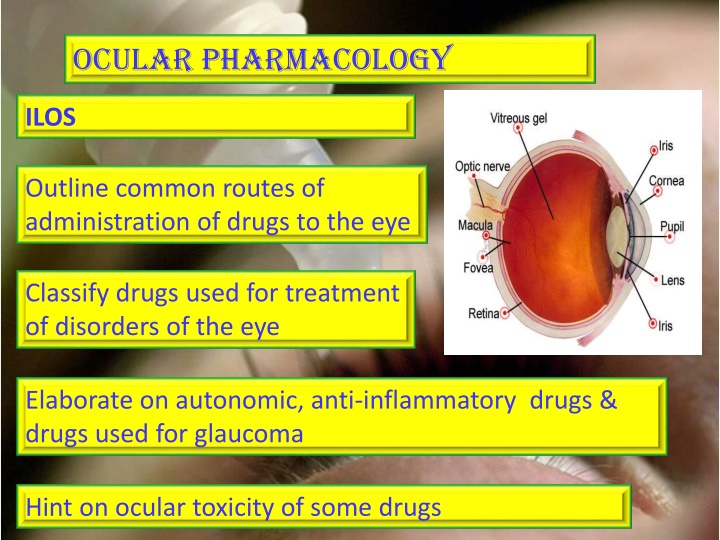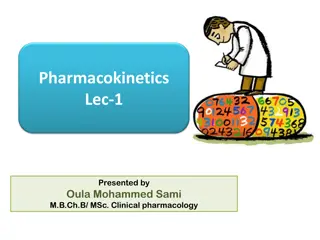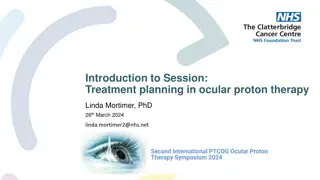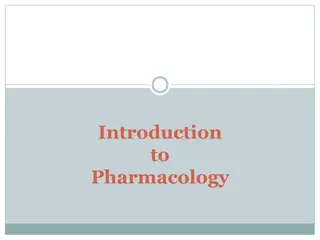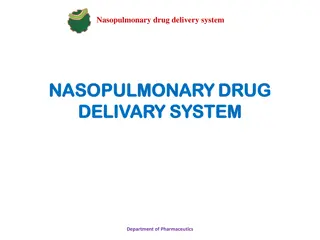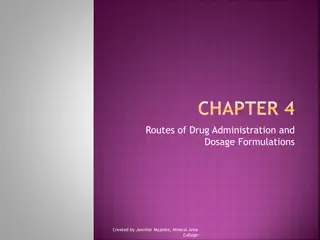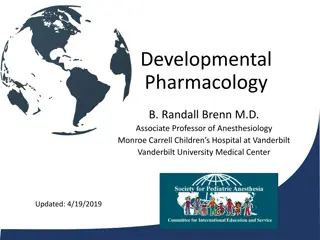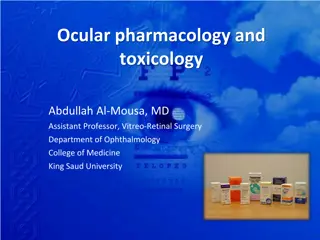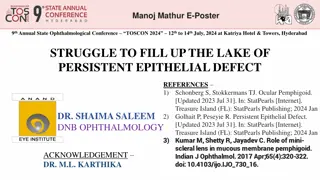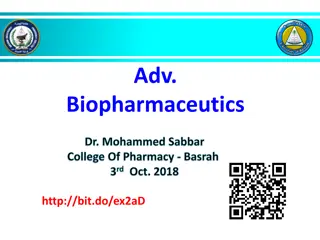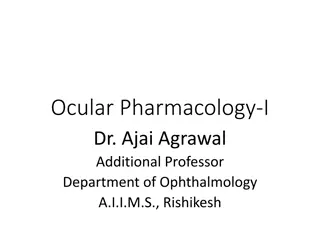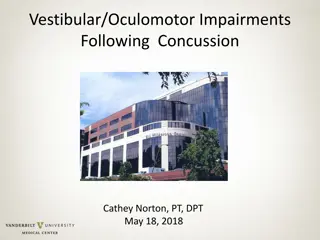Ocular Pharmacology: Routes of Administration and Drug Classes
Common routes of drug administration to the eye, including topical and systemic methods. Learn about drug classes used for eye disorders, such as autonomic drugs, anti-inflammatory agents, and glaucoma medications. Gain insights into ocular toxicity risks associated with certain drugs.
Download Presentation

Please find below an Image/Link to download the presentation.
The content on the website is provided AS IS for your information and personal use only. It may not be sold, licensed, or shared on other websites without obtaining consent from the author.If you encounter any issues during the download, it is possible that the publisher has removed the file from their server.
You are allowed to download the files provided on this website for personal or commercial use, subject to the condition that they are used lawfully. All files are the property of their respective owners.
The content on the website is provided AS IS for your information and personal use only. It may not be sold, licensed, or shared on other websites without obtaining consent from the author.
E N D
Presentation Transcript
Ocular pharmacology the eye ILOS Outline common routes of administration of drugs to the eye Classify drugs used for treatment of disorders of the eye Elaborate on autonomic, anti-inflammatory drugs & drugs used for glaucoma Hint on ocular toxicity of some drugs
Routes of administration administration of drugs to the eye 1- Topical Eye drops administration of drugs to the eye Ointments Injections administration of drugs to the eye 2- Systemic Oral, IV
Topical applications Advantages Convenient Economic Relatively safe Disadvantages Compliance Corneal & conjunctival toxicity
Local injections Local injections i- Periocular Subconjunctival, peribulbar, retrobulbar, or subtenon ii- Intraocular Intracameral or intravitreal
Peri Peri- -ocular injections ocular injections Subconjunctival, subtenon, peribulbar, or retrobulbar For infection of anterior segment and inflammation of uvea bypass the conjunctival and corneal epithelium which is good for drugs with low lipid solubility (e.g. penicillins) steroid and local anesthetics Local toxicity, tissue injury, globe perforation, optic nerve damage
Intraocular injections For anterior segment surgery, infections & retinitis Intracameral acetylcholine during cataract surgery Intravitreal antibioticsin cases of endophthalmitis Intravitreal steroid in macular edema ADRS: Retinal, intraocular , corneal toxicity
Systemic drugs Factor influencing systemic drug penetration into ocular tissue lipid solubility of the drug: more penetration with high lipid solubility Protein binding: more effect with low protein binding Eye inflammation: more penetration with ocular inflammation
Ocular drugs Miotics Mydriatics Cycloplegics Autonomic drugs Antiglaucoma Drugs Anti-inflammatory drugs Steroids & NSAIDs Chemotherapeutics Antibacterial, antifungal, antiviral, antimitotic Local anesthetics Ocular lubricants
Autonomic drugs Parasympathetic Drugs Constriction of the pupillary sphincter muscle (miosis) Contraction of the ciliary muscle (accommodation for near vision). contraction of ciliary muscle accommodation for near vision Increase aqueous outflow through the trabecular meshwork into canal of Schlemm by ciliary muscle contraction Decrease intraocular pressure Increase lacrimation Conjunctival vasodilatation
Parasympathetic Drugs Clinical uses Glaucoma (open and close angle) Drugs Acetycholine Ocular uses Counteract action of mydriatics Carbachol Methacholine Induction of miosis in surgery Glaucoma -To break adhesions Pilocarpine In open angle glaucoma -In accommodative esotropia (ecothiophate) Glaucoma, accommodative esotropia Physostigmine -In lice infestation of lashes (physostigmine) Ocular ADRS Glaucoma, accommodative esotropia Ecothiophate Diminished vision (myopia), headache
Cholinergic antagonists Cholinergic antagonists Mydriasis due to relaxation of circular muscles Cycloplegia (loss of near accommodation) due to relaxation of ciliary muscles Loss of light reflex Increased I.O.P Lacrimal secretion sandy eye
Cholinergic antagonists Cholinergic antagonists Clinical uses -To prevent adhesion in uveitis & iritis -Funduscopic examination of the eye -Measurement of refractive error
Adrenergic agonists uveoscleral outflow Non-selective agonists Mechanism: uveoscleral outflow of aqueous humor Uses: open angle glaucoma 1 agonists e.g. phenylepherine Mydriasis (without cycloplegia) -Funduscopic examination of the eye -Decongestant in minor allergic hyperemia of eye -To prevent adhesion in uveitis & iritis
Adrenergic agonists 2 agonists e.g. apraclonidine Mechanism: production of aqueous humor Uses: glaucoma treatment, Prophylaxis against IOP spiking after glaucoma laser procedures
- blockers blockers non-selective: timolol, carteolol selective: betaxolol (beta 1 cardioselective ) Mechanism: Act on ciliary body to production of aqueous humor Uses: open angle glaucoma Advantages can be used in patients with hypertension/ischemic heart disease Ocular ADRS:- irritation
Treatment of open angle Treatment of open angle glaucoma (chronic) glaucoma (chronic) Goal is to decrease IOP Decreasing production of aqueous humor - blockers 2 agonists Carbonic anhydrase inhibitors Increasing outflow of aqueous humor Prostaglandins Adrenergic agonists (non-specific) uveoscleral outflow Parasympathomimetics
Carbonic Carbonic anhydrase anhydrase inhibitors inhibitors Acetazolamide (oral), Dorzolamide (topical) Mechanism:- production of aqueous humor Side Effects: myopia, malaise, anorexia, GI upset, headache metabolic acidosis, renal stone, Contraindications: sulpha allergy, digitalis users, pregnancy
prostaglandins Latanoprost Mechanism: Uveoscleral outflow Uses: open angle glaucoma Administration: Topical drops Side Effects: Iris color change
Drug Therapy of acute angle Drug Therapy of acute angle closure glaucoma (narrow angle) closure glaucoma (narrow angle) Acute, painful increases of pressure Is associated with occlusion of the outflow drainage pathway Emergency situation that require treatment before surgery (Iridectomy) Oral Acetazolamide Topical cholinomimetics e.g.: pilocarpine Dehydrating agents: IV infusion Of hypertonic solution ( Mannitol, Glycerol) Analgesics: pethidine or morphine (for pain)
Osmotic agents Osmotic agents Glycerol 50% syrup (cause nausea, hyperglycemia) Mannitol 20% IV (cause fluid overload and not used in heart failure) Clinical uses Dehydrate vitreous body which reduce IOP prior to anterior surgical procedures Used for short term management of acute rise in IOP
Corticosteroids Mechanism:- Inhibition of arachidonic acid release by inhibiting phospholipase A2 Topical:-prednisolone, dexamethasone, hydrocortisone Uses: postoperatively, anterior uveitis, severe allergic conjunctivitis, scleritis, prevention and suppression of corneal graft rejection Systemic:- prednisolone, cortisone Uses: posterior uveitis, optic neuritis Ocular ADRS:-Glaucoma, cataract, skin atrophy, secondary infection, delayed wound healing.
NSAIDs e.g. flurbiprofen, diclofenac, ketorolac Mechanism: inhibition of cyclo-oxygenase Uses: Flurbiprofen preoperatively to prevent miosis following cataract surgery Diclofenac for postoperative inflammation Ketorolac for cystoid macular edema occurring after cataract surgery Side effects: stinging , sterile corneal melt& perforation
toxicology Digitalis causes chromotopsia with overdose Chloroquine causes retinopathy Amiodarone causes optic neuropathy & pigmented deposits of the cornea Phenothizines cause brown pigmentary deposits in the cornea, conjunctiva & eyelid
Sildenafil Inhibits PDE5 in the corpus cavernosum to achieve penile erection It also mildly inhibits PDE6 which controls the level of cyclic GMP in the retina seeing a bluish haze & causing light sensitivity Steroids cataract formation, elevated IOP & glaucoma Ethambutol optic neuropathy characterized by gradually progressive central scotomas & vision loss
